A Gardner's Dozen—Martin's Scientific American Cover Stories
Martin wrote about 300 articles for Scientific American between 1952 and 1998, most famously in his legendary "Mathematical Games" column starting in Jan 1957. Many of those articles are now viewed as classics, from his seminal piece on hexaflexagons in Dec 1956—which led to the offer to write a regular column for the magazine—to his breakthrough essays on pentomnoes, rep-tiles, the Soma cube, the art of Escher, the fourth dimension, sphere packing, Conway's game of Life, Newcomb's paradox, Mandelbrot's fractals, Penrose tiles, and RSA cryptography, not forgetting the recurring numerological exploits of his alter ego Dr. Matrix, and the tongue-in-cheek April Fool column from 1975.
Many of those gems just listed were associated with beautiful graphics and artwork, so it's no surprise that Martin scored some Scientific American covers over the years, though as we'll see below, there's surprisingly little overlap between his "greatest hits" and his "cover stories."
It's worth noting that, just as the magazine editors selected the titles under which his original articles appeared—he generally ditched those in favor of his own when he republished them in the spin-off books—artwork submitted was often altered by Scientific American staff artists.
The number of his cover stories is a tidy dozen, and here they are.
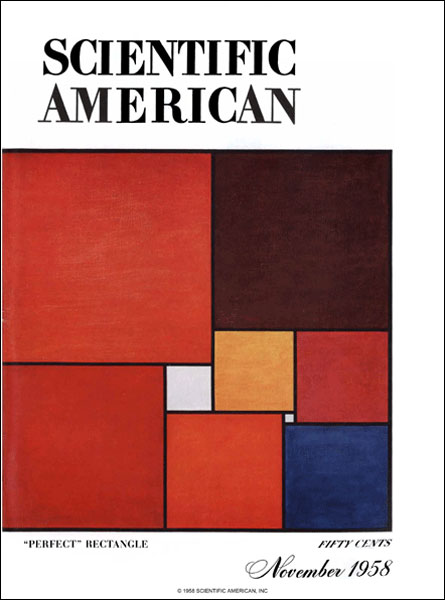
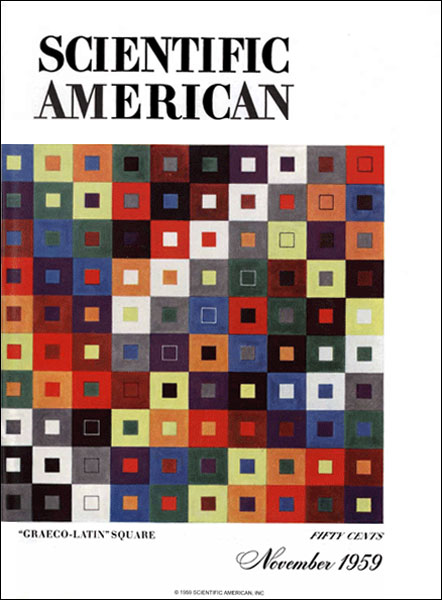

Vol 199, No 5, Nov 1958 | "How rectangles, including squares, can be divided into squares of unequal size"
Included (in revised form) as "Squaring the Square" in More Mathematical Puzzles and Diversions (1962). See the Wikipedia article "Squaring the Square" explores this and related topics..
Vol 201, No 5, Nov 1959 | "How three modern mathematicians disproved a celebrated conjecture of Leonhard Euler"
Graeco-Latin squares, i.e., orthogonal Latin squares, had been studied by Euler, who showed in the 1780s that they existed if the square side was odd or a multiple of 4. He conjectured that none existed for other even values, although it wasn't until 1901 that the case of 6 was definitively ruled out. In the late 1950s, an example of size 22 was found by R. C. Bose and S. S. Shrikhande, much to everyone's surprise. With computer help, E. T. Parker found a size 10 example, and in Apr 1959, the three mathematicians announced the existence of examples for all sizes except unlucky 6. Euler had made an uncharacteristically poor guess.
Included (in revised form) as "Euler's Spoilers: The Discovery of an Order-10 Graeco-Latin Square" in New Mathematical Diversions from Scientific American (1966).
Vol 204, No 4, Apr 1961 | "Diversions in a new book on geometry (Coxeter's Introduction to Geometry)"
Included (in revised form) as "H.S.M. Coxeter" in New Mathematical Diversions from Scientific American) (1966). This cover feature a staff-colorized version of a now-iconic M. C. Escher image, which the Dutch artist had offered Martin the use of after writing to him to express his admiration for The Annotated Alice from 1960.
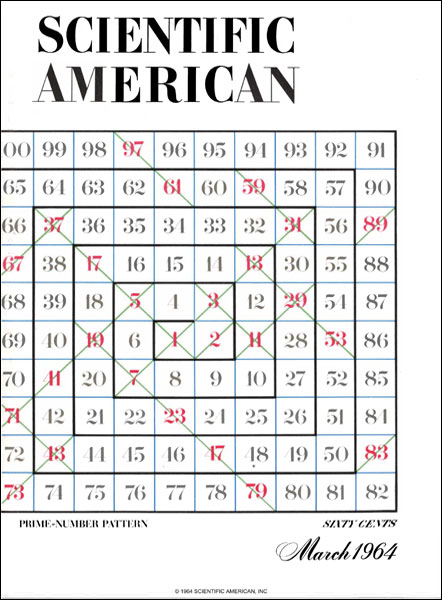
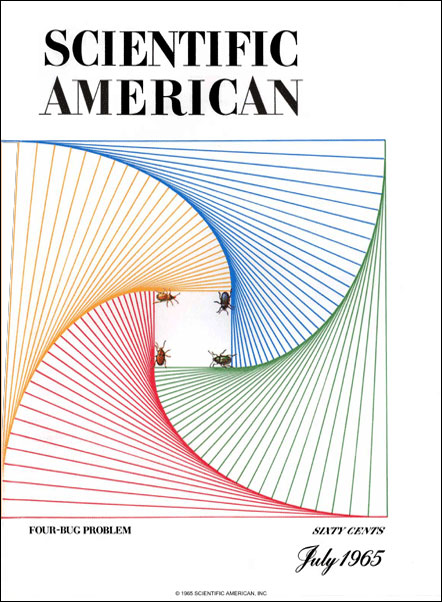
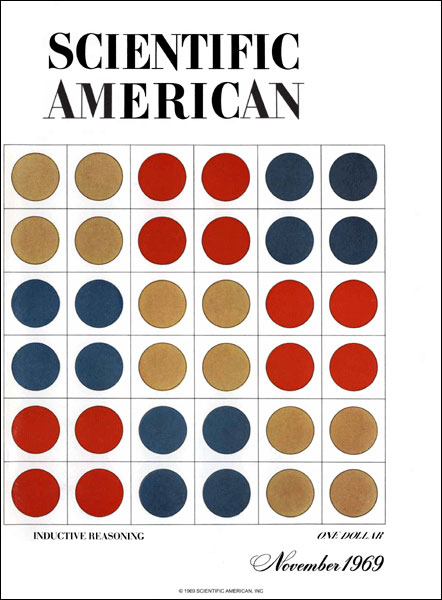
Vol 210, No 3, Mar 1964 | "The remarkable lore of prime numbers"
This hot-off-the-press item concerned Stan Ulam's discovery of a new pattern in the distribution of prime numbers when the counting numbers are displayed in a square spiral, and was strikingly illustrated by an early example of a computer generated binary image. The cover image—effectively a colorized re-creation of the doodle which lead Ulam to his discovery in 1963—spoke volumes.
Included (in revised form) as "Patterns and Primes" in Martin Gardner's Sixth Book of Mathematical Diversions from "Scientific American" (1971).
Vol 213, No 1, Jul 1965 | "Four bug problem"
Included (in revised form) as "Op Art" in Martin Gardner's Sixth Book of Mathematical Diversions from Scientific American (1971).
Vol 221, No 5, Nov 1969 | "Patterns"(1969)
Featured the game Patterns from Sid Sackson's Book A Gamut of Games. Included (in revised form) as "Patterns of Induction" in Mathematical Circus (1978).
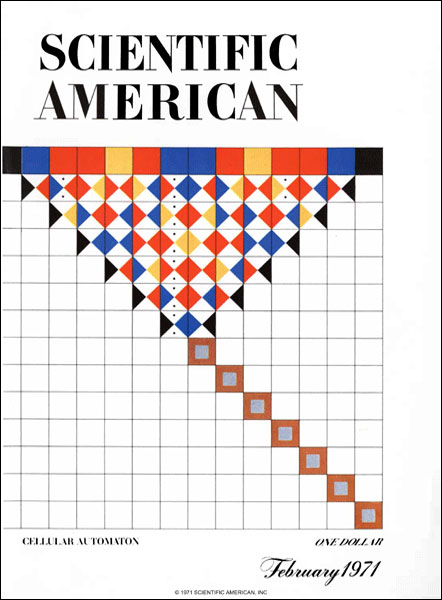

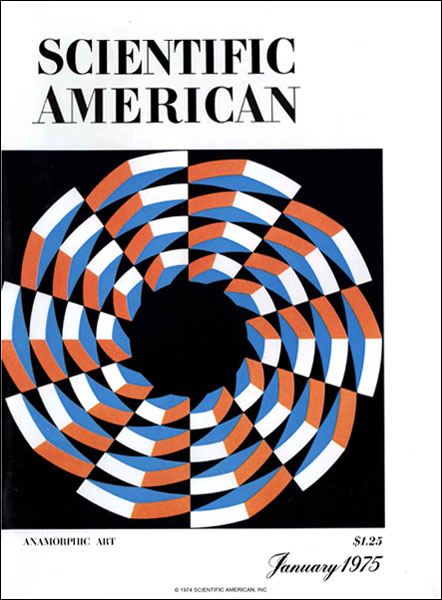
Vol 224, No 2, Feb 1971 | "Cellular automata"
Martin's Oct 1970 account of John H. Conway's cellular automata game of Life was perhaps his biggest journalistic success ever, spurring immediate and sustained interest among both mathematicians and computer scientists, but it didn't make the cover. This follow-up did. It's included (in revised form) as "The Game of Life, Part II" in Wheels, Life and Other Mathematical Amusements (1983). See Alvy Ray Smith's story of how the cover image came about.
Vol 230, No 1, Jan 1974 | "I Ching"
Included (in revised form) as "The I Ching" in Knotted Doughnuts and Other Mathematical Entertainments (1986).
Vol 232, No 1, Jan 1975 | "The curious magic of anamorphic art"
Included (in revised form) as "Anamorphic Art" in Time Travel and Other Mathematical Bewilderments (1988).
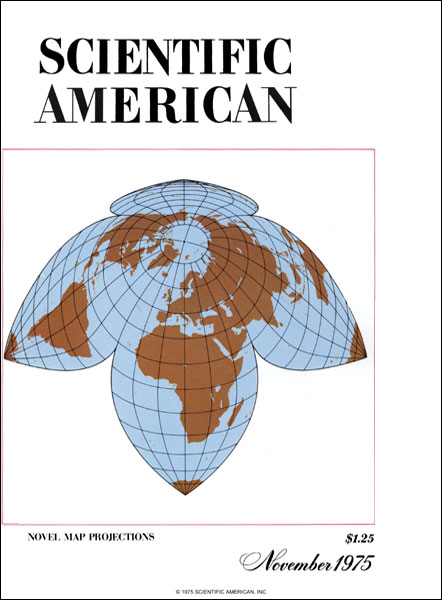
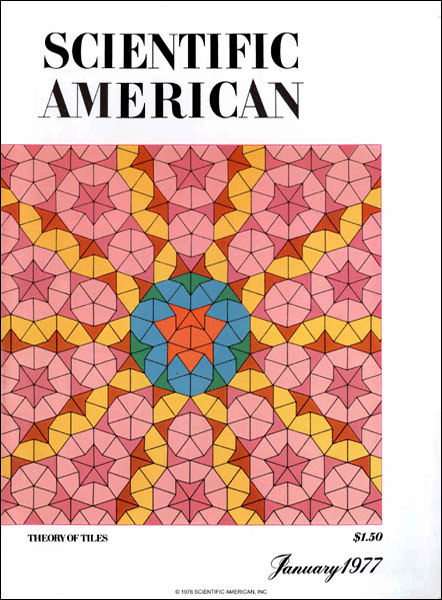
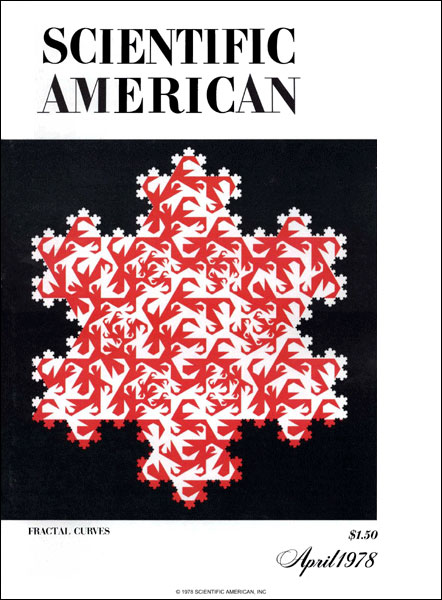
Vol 233, No 5, Nov 1975 | "On map projections (with special reference to some inspired ones"
Included (in revised form) as "Curious Maps" in Time Travel and Other Mathematical Bewilderments (1988).
Vol 236, No 1, Jan 1977 | "Extraordinary nonperiodic tiling that enriches the theory of tiles"
Here, Martin explains the developments leading to the discovery and recent refinement of sets of tiles that can only tile the plane aperiodically; those now called Penrose tiles (or, darts and kites, in Conway's notation). Included (in revised form) as "Penrose Tiling I" in Penrose Tiles to Trapdoor Ciphers...and the Return of Dr. Matrix (1989). The original sketch for this cover was made by Conway.
Vol 238, No 4, Apr 1978 | "White and brown music, fractal curves and 1/f fluctuations"
Included (in revised form) as "White, Brown and Fractal Music" in Fractal Music, Hypercards and More (1992).
Thanks to the MAA, seven of Martin's classic Scientific American articles are available online, as they appeared in later books (expanded and updated). This includes some of the above cover story articles.
Martin Gardner's "Mathematical Games" columns (page 1)
The Canon: The fifteen "Mathematical Games" books (page 2)
The other "Mathematical Games" spin-offs (page 3)
What made "Mathematical Games" special (page 4)
Index to "Mathematical Games" (page 5)
"The Top 10 Martin Gardner Scientific American Articles" (page 7)
Puzzle Books / Logic / Calculus Made Easy / Articles / Reviews / Pleasure / Math Legacy